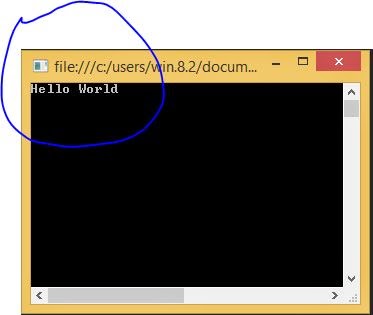Introduction
Now, we will learn basic structure of the c# program as well as building blocks. In this article, we will cover only basic structure of c#. In this article we will learn sample code plus provide additional background information.C# Hello World! Example
Simple c# program should take some minimum functionality
- Imported namespace ( How to use libraries)
- Namespace declaration (How to create new Namespace in c#)
- A class (How to design a class in c#)
- Class methods (Default class consist of single main() method, you can take other methods)
- Class Properties(it shows the behavior of the class as well as object)
- A Main method (its the entry point of the c# program)
- Statements & Expressions (You can put your ideas using statements and expression)
- Comments (Design user friendly using comments)
Lets take a simple that would print Hello World!, I have visual studio 2013 , you can take 2005 and above version.
using System;
using System.Collections.Generic;
using System.Linq;
using System.Text;
using System.Threading.Tasks;
namespace csharpprogram
{
class Program
{
static void Main(string[] args)
{
Console.WriteLine("Hello World");
Console.ReadKey(false);
}
}
}
If you want to compile and execute this code, press green triangle button, which is mentioned in VS IDE and see your result
Ok, Now understand what is in this program:
- The first five line of the program using System; and etc - the using keyword is most important keyword in c# library, you can take it in different purpose like The using block is used, where you want to deallocate resources forcefully. Also used where you want to add library references in the code. A program generally has multiple using statements.
- The next line has the namespace declaration. A namespace is a collection of classes, enum , delegates , structure and etc, also its not a replacement of assemblies. Here csharpprogram namespace consists of single Program class.
- The next line has a class declaration, the class Program contains data members and member functions, also known as encapsulation, which is discuss later. The data members shows the properties of the object and member functions shows behavior of the object. Like, we take a person as a object then we can take person name, person id, person address, etc as a data member and person_walk consider in member function.
- The next line defines the Main method, which is the entry point for all C# programs. The main method consists of various statement. In our c# program, we can take multiple main methods.
- The next line defines the WriteLine( ) method, which return the string output onto the screen. It is included in Console class , which is in System Namespace.
- Using the Console.ReadKey( ) method, which is overloaded by boolean values. You can take true as well as false as a argument in it. False parameter shows presses key onto the screen. Using This method compiler wait for a key press and it prevents the screen from running and closing quickly when the program is launched from Visual Studio .NET.
Note: Some Basic concepts about c#
- C# is a case sensitive language.
- Statement and expression end with semicolon(;)
- Always C# program start from main method.
How to Compile & Execute a C# Program: lets check this video.






